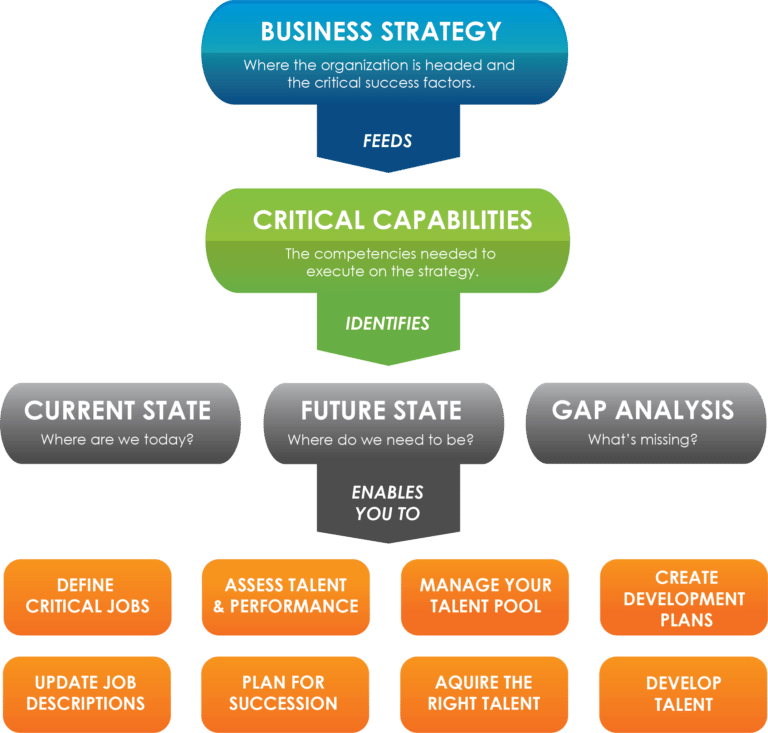Home » Services » Optimize & Transition » Workforce Planning and Strategy Alignment
Workforce Planning and Strategy Alignment
Translate your business strategy into a talent strategy
An organization’s ability to achieve its business strategy is predicated on mobilizing the talent required to successfully execute the strategy. The people side of the equation may well be the most crucial element that differentiates an organization from the competition. Talent is critical to organizational growth and business continuity, so aligning the people strategy with the business strategy is an essential business requisite in a strategic workforce planning model. Without workforce forecasting, an organization is not fully aware of its current and future workforce needs, which can impact business alignment.
What Is Workforce Planning?
Workforce planning is incredibly vital in today’s ever-changing environment to ensure your organization has the required talent to match your workforce’s capacity and capabilities to meet business demands, now and in the future. Workforce and strategic alignment planning are the people side of planning in business; it’s a systematic process that involves proactively identifying and analyzing current workforce gaps and forecasting future staffing needs to avoid potential over or understaffing. It also ensures the right people are in the right roles at the right time with the proper skill set.
CCI Consulting’s Strategic Workforce Planning Model
CCI helps organizations identify clear outcomes. Our role is not to provide a pre-designed strategic planning solution but rather to understand and create people processes and approaches that align with your organizational goals. Creating a tailored talent strategy that aligns with your business strategy helps to smooth succession planning, increases the organization’s ability to respond to growth opportunities, and improves the overall performance of the organization. This is what we call an alignment model for strategic planning.

Our strategic alignment model will provide you with the information you need to answer the following questions:
- Where are we today?
- Where do we need to be?
- What is missing?
By answering these questions, you can strengthen your team, your processes, and your organization as a whole.
Basic Principles of Workforce Planning
CCI assists HR professionals in identifying and regularly analyzing talent needs and linking human capital strategy and policies to business goals to drive results. We believe the following principles should guide decisions about organizational design and talent development:
- Organizational structure needs to facilitate accomplishing the organization’s purpose and objectives by focusing on the key priorities.
- Structure and systems should be as simple as possible while effectively supporting decision-making, planning, and performance monitoring.
- Roles and responsibilities should be clearly defined, and accountabilities should be clearly established.
Strategic Workforce Planning Begins with Business Alignment and Strategy
Assess what you need to do to get where you want your business to be. At CCI, we have been helping small, mid-sized, and large companies for over thirty years with strategic workforce planning and business alignment processes. With our help, you’ll get an actionable workforce strategy tailored to your organization so that the business and the people who make it run are prepared for today and the future.
Contact us at (267) 656-7168 to learn how our workforce planning and forecasting services will benefit your organization.

Our Services
Contact Us
Case Studies
Challenge:
One of the largest compounding pharmacies in the United States needed to make strengthening leadership, managerial and supervisory capacity at the company a priority. The organization had seen steady growth over the prior decade, growing from a start-up to an industry leader in a relatively short period of time. An organized leadership development program was never offered to its staff, resulting in the business beginning to outpace their capabilities. Having worked with CCI two years earlier to develop a competency model, the company engaged CCI to create a developmental program for all its people leaders.
Solution:
To gain insight and perspective into the needs of the organization, CCI used the previously identified competencies as a back drop while conducting a comprehensive learning needs assessment. To understand and prioritize the needs, CCI conducted face-to-face interviews with each member of the leadership team and several high-performing employees. In addition, an electronic training needs survey was administered to each leadership level within the organization. As a result of the findings and recommendations, CCI’s Talent Development consultants designed a developmental training curriculum for four levels of people leaders: Director, Manager, Supervisor, and Assistant Supervisor. Each level included six workshops with topics based on the prioritized gaps from the training needs assessment. To reinforce the training, the leadership team was briefed on the topics and provided a “manager’s toolkit” so they could provide support to their direct reports. Also, the sessions were scheduled in a cascading fashion that allowed for the more senior audience to experience the training first so they could support their direct reports as they went through the workshops. At the program’s onset, each participant also identified a Burning Imperative. This was their own BHAG they were responsible for completing within the next year. After each session, the participants were responsible for applying what they learned to their imperative.
Results:
The primary mechanism for measuring program success was through session evaluations. Each cohort-level was asked to complete a session evaluation at the conclusion of each workshop. In addition to the qualitative responses, the three questions of most interest were:
- As a result of the program, I will be a stronger performer for the organization.
- I would rate my performance in this area before this program.
- I would rate my ability to apply what I’ve learned when I return to my team.
The following grid shows how each group responded with Top 2 answers (Agree/Strongly Agree or Above Average/Exceptional) on a five-point Likert scale.
| Q1 | Q2 | Q3 | Delta Q2 & Q3 | |
| Asst. Supervisors | 100% | 48% | 91% | 43 points |
| Supervisors | 96% | 28% | 86% | 58 points |
| Managers | 93% | 27% | 65% | 38 points |
| Directors | 89% | 21% | 71% | 50 points |
Overall, the participant feedback was considered very positive and this data indicates the value perceived by the audience. Nearly all the participants felt as though they would be stronger performers as a result of the leadership training.
Challenge
New CEO and VP of HR needed to change the leadership culture to better align with market demands and to develop leaders. Goals: Drive a culture change from corporate command-and-control to more localized decision making. Target audience was managers, frontline supervisors, and high potential management prospects. Needed a real-world business training approach that would provide actionable learning.
Solution
CCI designed a customized course of interactive sessions to improve essential management skills and to connect the skills to real business situations and company operations. The course was delivered multiple times, in six single-day sessions, one per month over a six month period. Participants of the course were provided with new tools and techniques they could use immediately, driving changes to company culture while improving employee engagement.
Results
More than 60 managers completed the course over a two-year period. A clear understanding was gained of the difference between a leader and a manager. The CEO described the course as “a key tool in facilitating a culture change from command-and-control to more localized decision making.” Participants were able to successfully pass on to their direct reports the tools, techniques and lessons they had learned.
Challenge:
One of the largest compounding pharmacies in the United States needed to make strengthening leadership, managerial and supervisory capacity at the company a priority. The organization had seen steady growth over the prior decade, growing from a start-up to an industry leader in a relatively short period of time. An organized leadership development program was never offered to its staff, resulting in the business beginning to outpace their capabilities. Having worked with CCI two years earlier to develop a competency model, the company engaged CCI to create a developmental program for all its people leaders.
Solution:
To gain insight and perspective into the needs of the organization, CCI used the previously identified competencies as a back drop while conducting a comprehensive learning needs assessment. To understand and prioritize the needs, CCI conducted face-to-face interviews with each member of the leadership team and several high-performing employees. In addition, an electronic training needs survey was administered to each leadership level within the organization. As a result of the findings and recommendations, CCI’s Talent Development consultants designed a developmental training curriculum for four levels of people leaders: Director, Manager, Supervisor, and Assistant Supervisor. Each level included six workshops with topics based on the prioritized gaps from the training needs assessment. To reinforce the training, the leadership team was briefed on the topics and provided a “manager’s toolkit” so they could provide support to their direct reports. Also, the sessions were scheduled in a cascading fashion that allowed for the more senior audience to experience the training first so they could support their direct reports as they went through the workshops. At the program’s onset, each participant also identified a Burning Imperative. This was their own BHAG they were responsible for completing within the next year. After each session, the participants were responsible for applying what they learned to their imperative.
Results:
The primary mechanism for measuring program success was through session evaluations. Each cohort-level was asked to complete a session evaluation at the conclusion of each workshop. In addition to the qualitative responses, the three questions of most interest were:
- As a result of the program, I will be a stronger performer for the organization.
- I would rate my performance in this area before this program.
- I would rate my ability to apply what I’ve learned when I return to my team.
The following grid shows how each group responded with Top 2 answers (Agree/Strongly Agree or Above Average/Exceptional) on a five-point Likert scale.
| Q1 | Q2 | Q3 | Delta Q2 & Q3 | |
| Asst. Supervisors | 100% | 48% | 91% | 43 points |
| Supervisors | 96% | 28% | 86% | 58 points |
| Managers | 93% | 27% | 65% | 38 points |
| Directors | 89% | 21% | 71% | 50 points |
Overall, the participant feedback was considered very positive and this data indicates the value perceived by the audience. Nearly all the participants felt as though they would be stronger performers as a result of the leadership training.
Challenge
New CEO and VP of HR needed to change the leadership culture to better align with market demands and to develop leaders. Goals: Drive a culture change from corporate command-and-control to more localized decision making. Target audience was managers, frontline supervisors, and high potential management prospects. Needed a real-world business training approach that would provide actionable learning.
Solution
CCI designed a customized course of interactive sessions to improve essential management skills and to connect the skills to real business situations and company operations. The course was delivered multiple times, in six single-day sessions, one per month over a six month period. Participants of the course were provided with new tools and techniques they could use immediately, driving changes to company culture while improving employee engagement.
Results
More than 60 managers completed the course over a two-year period. A clear understanding was gained of the difference between a leader and a manager. The CEO described the course as “a key tool in facilitating a culture change from command-and-control to more localized decision making.” Participants were able to successfully pass on to their direct reports the tools, techniques and lessons they had learned.
Learn How CCI Can Help
We welcome the opportunity to connect and support you across a broad range of all your talent and HR needs.

